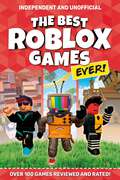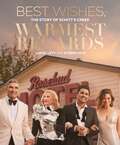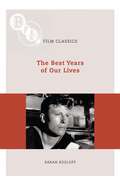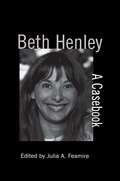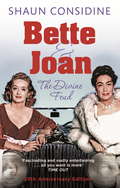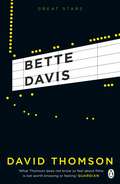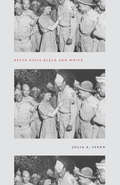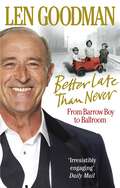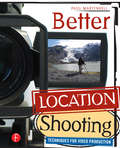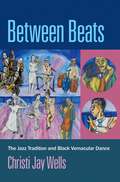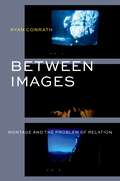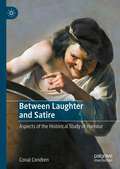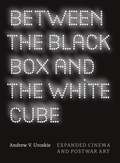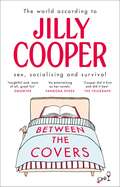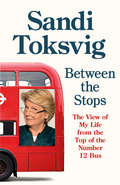- Table View
- List View
The Best Roblox Games Ever: Over 100 games reviewed and rated! (Roblox)
by Kevin PettmanThere are thousands of games in Roblox, and this book tells you which ones are the very best. Whether you're brand new to Roblox or a seasoned veteran, you'll need this essential, independent guide. Over 100 games are profiled and rated, with game divided up by genre. As well as giving each game a Roblox Rating, it's filled with tons of cool and quirky facts about each game, as well as the latest stats on popularity, difficulty, gameplay and more. This is the only 100% unofficial, completely authoritative guide to Roblox games you'll ever need.
Best Wishes, Warmest Regards: The Story of Schitt's Creek
by Daniel Levy Eugene LevyThis beautifully produced, lavishly illustrated book is the ultimate celebration of the series, the town, the characters, and the state of mind that is Schitt's Creek. Capturing the essence and alchemy of all six seasons of what is now considered to be one of the most groundbreaking comedy television series of the last decade, Best Wishes, Warmest Regards is a gift to fans everywhere who have made the show their own.Included are character profiles from the cast of Johnny, Moira, David, and Alexis, and all of the characters that populate the town, major moments from Moira's endorsement of Herb Ertlinger Winery, to Patrick and David's first kiss, to Cabaret and the Rose Family Christmas episode. Also included are special features, such as the complete, illustrated catalogs of David's knits and Moira's wigs, Moira's vocabulary, Alexis's adventures, and behind-the-scenes moments from Dan and Eugene Levy and the cast of Schitt's Creek.
The Best Years of Our Lives (BFI Film Classics)
by Sarah KozloffWilliam Wyler's The Best Years of Our Lives (1946) tells the story of three veterans returning from World War II and adjusting to civilian life in a manner unusual for classical Hollywood cinema, with melodrama leavened by authentic detail, personal memories and a fierce desire to capture its historical moment. Sarah Kozloff's illuminating study of the film traces the contribution of Wyler (himself injured while serving in the US Air Force), Robert Sherwood's screenplay, Gregg Toland's deep-focus cinematography, Hugo Friedhofer's award-winning score, and the ensemble cast of Myrna Loy, Fredric March, Dana Andrews, Teresa Wright and Harold Russell. The film's poignant message spoke to American audiences reeling from the end of the conflict and the bumpy transition to peace: producer Samuel Goldwyn received hundreds of letters from ex-servicemen about how accurately his production had captured their experiences.Despite winning nine Academy Awards, Best Years was soon engulfed in political conflict from both the right and the left. Disagreements about the film's politics foreshadowed HUAC's anti-Communist investigations and the fracturing of the Hollywood community that culminated in the collapse of the studio system. Sarah Kozloff's discussion of the film's development, production and reception history draws on archival research to shed new light on our understanding of this much-loved movie, and to bring The Best Years of Our Lives back where it belongs: in our collections, in our libraries, and in our hearts.
Beth Henley: A Casebook (Casebooks on Modern Dramatists)
by Julia A. FesmireFirst Published in 2002. Routledge is an imprint of Taylor & Francis, an informa company.
Beth Henley: A Casebook (Casebooks on Modern Dramatists #33)
by Julia A. FesmireFirst Published in 2002. Routledge is an imprint of Taylor & Francis, an informa company.
Bette And Joan: Divine Feud
by Shaun Considine'An absolute must-read' VANITY FAIRBette Davis and Joan Crawford: two of the deadliest arch-rivals of all time. Born in the same year (though Davis swore 'Crawford is five years older than me if she's a day'), the two fought bitterly throughout their long and brilliant Hollywood careers. Joan became a star first, which always irked her rival, who suggested her success had come via the casting couch. 'It sure as hell beats the hard cold floor' was Crawford's scathing response. According to Davis, Crawford was not only a nymphomaniac but also 'vain, jealous and about as stable and trustworthy as a basket of snakes'. Crawford, in turn, accused Davis of stealing her glory and planning to destroy her.The two rivals fought over as many men as they did parts - when Bette fell in love with her co-star in DANGEROUS, Franchot Tone, Joan stepped in and married him. The women worked together only once, in the classic thriller WHATEVER HAPPENED TO BABY JANE?, in which their violent hatred of each other as rival sisters was no act.'Shaun Considine's story of the two divas is vastly informative and in parts hilarious' SUNDAY TELEGRAPH'Fascinating and vastly entertaining . . . all you want is more' TIME OUT 'Considine's well-researched book is an account of one of Hollywood's most extraordinary relationships' DAILY EXPRESS '[A] Scurrilously readable twin biography' MAIL ON SUNDAY'Considine's dual biography is a guilty pleasure' SUNDAY HERALD'Brilliant, outrageous and hysterical' Suranne Jones (Star of BBC One's Doctor Foster)
Bette Davis (Great Stars Ser.)
by David Thomson'She could look demure while behaving like an empress. Blonde, with eyes like pearls too big for her head, she was very striking, but marginally pretty and certainly not beautiful ... But it was her edge that made her memorable - her upstart superiority, her reluctance to pretend deference to others.'Bette Davis was the commanding figure of the great era of Hollywood stardom, with a drive and energy that put her contemporaries in the shade. She played queens, jezebels and bitches, she could out-talk any male co-star, she warred with her studio, Warner Bros, worked like a demon, got through four husbands, was nominated for seven Oscars and - no matter what - never gave up fighting. This is her story.
Bette Davis Black and White
by Julia A. SternBette Davis’s career becomes a vehicle for a deep examination of American race relations. Bette Davis was not only one of Hollywood’s brightest stars, but also one of its most outspoken advocates on matters of race. In Bette Davis Black and White, Julia A. Stern explores this largely untold facet of Davis’s brilliant career. Bette Davis Black and White analyzes four of Davis’s best-known pictures—Jezebel (1938), The Little Foxes (1941), In This Our Life (1942), and What Ever Happened to Baby Jane? (1962)—against the history of American race relations. Stern also weaves in memories of her own experiences as a young viewer, coming into racial consciousness watching Davis’s films on television in an all-white suburb of Chicago. Davis’s egalitarian politics and unique collaborations with her Black costars offer Stern a window into midcentury American racial fantasy and the efforts of Black performers to disrupt it. This book incorporates testimony from Davis’s Black contemporaries, including James Baldwin and C. L. R. James, as well as the African American fans who penned letters to Warner Brothers praising Davis’s work. A unique combination of history, star study, and memoir, Bette Davis Black and White allows us to contemplate cross-racial spectatorship in new ways.
Bette Davis Black and White
by Julia A. SternBette Davis’s career becomes a vehicle for a deep examination of American race relations. Bette Davis was not only one of Hollywood’s brightest stars, but also one of its most outspoken advocates on matters of race. In Bette Davis Black and White, Julia A. Stern explores this largely untold facet of Davis’s brilliant career. Bette Davis Black and White analyzes four of Davis’s best-known pictures—Jezebel (1938), The Little Foxes (1941), In This Our Life (1942), and What Ever Happened to Baby Jane? (1962)—against the history of American race relations. Stern also weaves in memories of her own experiences as a young viewer, coming into racial consciousness watching Davis’s films on television in an all-white suburb of Chicago. Davis’s egalitarian politics and unique collaborations with her Black costars offer Stern a window into midcentury American racial fantasy and the efforts of Black performers to disrupt it. This book incorporates testimony from Davis’s Black contemporaries, including James Baldwin and C. L. R. James, as well as the African American fans who penned letters to Warner Brothers praising Davis’s work. A unique combination of history, star study, and memoir, Bette Davis Black and White allows us to contemplate cross-racial spectatorship in new ways.
Better Late Than Never: From Barrow Boy to Ballroom
by Len GoodmanBetter Late Than Never is the extraordinary true story of how a man born into poverty in London's East End went on to find stardom late in life when he was chosen to be head judge on BBC1's Strictly Come Dancing. Len Goodman tells all about his new-found fame, his experiences on Strictly Come Dancing, and also on the no.1 US show Dancing with the Stars and his encounters with the likes of Heather Mills-McCartney and John Sergeant. But the real story is in his East End roots. And Len's early life couldn't be more East End. The son of a Bethnal Green costermonger he spent his formative years running the fruit and veg barrow and being bathed at night in the same water Nan used to cook the beetroot. There are echoes of Billy Elliot too. Though Len was a welder in the London Docks, he dreamt of being a professional footballer, and came close to making the grade had he not broken his foot on Hackney Marshes. The doctor recommended ballroom dancing as a light aid to his recovery. And Len, it turned out, was a natural. At first his family and work mates mocked, but soon he had made the final of a national competition and the welders descended en masse to the Albert Hall to cheer him on. With his dance partner, and then wife Cheryl, Len won the British Championships in his late twenties and ballroom dancing became his life. Funny and heart-warming, Len Goodman's autobiography has all the honest East End charm of Tommy Steele, Mike Read or Roberta Taylor.
Better Location Shooting: Techniques for Video Production
by Paul MartingellLocation filming is growing in popularity with the abundance of affordable cameras. You don't need a studio, a broadcast truck, or even extensive knowledge of how to use a 16mm film camera--all you need is a digital camera, and you can take your job on the road and shoot wherever action is happening! This book will give you the knowledge and confidence you need to take your on-location shooting skills to the next level. Better Location Filming is packed with the things you will need to know to have great results while shooting your documentary, interview, sporting event, fashion or glamour event, or current affairs/news show. Beyond introductory techniques, the author will tell you how to plan, troubleshoot, handle legal requirements and issues, and of course - he'll teach you all about location filming equipment. Practical and filled with hands-on pointers, this book is perfect for working and aspiring film & video professionals seeking a leg up in their careers. As a bonus, advanced tips are included for novices who are ready to take shooting techniques to the next level.
Better Location Shooting: Techniques for Video Production
by Paul MartingellLocation filming is growing in popularity with the abundance of affordable cameras. You don't need a studio, a broadcast truck, or even extensive knowledge of how to use a 16mm film camera--all you need is a digital camera, and you can take your job on the road and shoot wherever action is happening! This book will give you the knowledge and confidence you need to take your on-location shooting skills to the next level. Better Location Filming is packed with the things you will need to know to have great results while shooting your documentary, interview, sporting event, fashion or glamour event, or current affairs/news show. Beyond introductory techniques, the author will tell you how to plan, troubleshoot, handle legal requirements and issues, and of course - he'll teach you all about location filming equipment. Practical and filled with hands-on pointers, this book is perfect for working and aspiring film & video professionals seeking a leg up in their careers. As a bonus, advanced tips are included for novices who are ready to take shooting techniques to the next level.
Between Beats: The Jazz Tradition and Black Vernacular Dance
by Christi Jay WellsBetween Beats: The Jazz Tradition and Black Vernacular Dance offers a new look at the complex intersections between jazz music and popular dance over the last hundred-plus years. Author Christi Jay Wells shows how popular entertainment and cultures of social dancing were crucial to jazz music's formation and development even as jazz music came to earn a reputation as a "legitimate" art form better suited for still, seated listening. Through the concept of choreographies of listening, the book explores amateur and professional jazz dancers' relationships with jazz music and musicians as jazz's soundscapes and choreoscapes were forged through close contact and mutual creative exchange. It also unpacks the aesthetic and political negotiations through which jazz music supposedly distanced itself from dancing bodies. Fusing little-discussed material from diverse historical and contemporary sources with the author's own years of experience as a social jazz dancer, it advances participatory dance and embodied practice as central topics of analysis in jazz studies. As it explores the fascinating history of jazz as popular dance music, it exposes how American anxieties about bodies and a broad cultural privileging of the cerebral over the corporeal have shaped efforts to "elevate" expressive forms such as jazz to elite status.
Between Beats: The Jazz Tradition and Black Vernacular Dance
by Christi Jay WellsBetween Beats: The Jazz Tradition and Black Vernacular Dance offers a new look at the complex intersections between jazz music and popular dance over the last hundred-plus years. Author Christi Jay Wells shows how popular entertainment and cultures of social dancing were crucial to jazz music's formation and development even as jazz music came to earn a reputation as a "legitimate" art form better suited for still, seated listening. Through the concept of choreographies of listening, the book explores amateur and professional jazz dancers' relationships with jazz music and musicians as jazz's soundscapes and choreoscapes were forged through close contact and mutual creative exchange. It also unpacks the aesthetic and political negotiations through which jazz music supposedly distanced itself from dancing bodies. Fusing little-discussed material from diverse historical and contemporary sources with the author's own years of experience as a social jazz dancer, it advances participatory dance and embodied practice as central topics of analysis in jazz studies. As it explores the fascinating history of jazz as popular dance music, it exposes how American anxieties about bodies and a broad cultural privileging of the cerebral over the corporeal have shaped efforts to "elevate" expressive forms such as jazz to elite status.
Between Images: Montage and the Problem of Relation
by Ryan ConrathIn the early days of moving pictures, filmmakers learned that the montage could be an effective tool to show changes in time or locale. Casablanca's iconic travel montage is mimicked by filmmakers to this day. Since its use in Rocky, the training montage has become a staple for sports films. In the 2004 film Team America, the song "Montage" is a meta explanation of the device's universal use and understanding. Its history and affects are studied and practiced by student and professional filmmakers alike. "Between Images proposes a unique theory of montage a technique of relation: a way of rethinking and reshaping how humans relateDLto ourselves and each other, to the material world, to the planet and its nonhuman inhabitants. Historically, film criticism has cast editing in one of several roles: as a device of spatiotemporal continuity to maintain the viewer's investment in the story-world; as an agent of disorder that confounds conventions of realism to prompt the viewer's intellectual engagement; and as an expressionistic device for augmenting the duration and combination of shots to leave a sensory impression. While not abandoning such accounts, this book ventures closer to the heart of montage by distinguishing the space between images as itself a powerful source of political, emotional, and aesthetic formation. Venturing into an "expanded field of montage," this study traces the cut and the splice across photographic and cinematic media, where the space between images becomes a setting for navigating and renegotiating the terms of relation, of the "being-with" that connects all forms of life. Between Images brings together a diverse cast of established and emerging film artistsDLHarun Farocki, Hito Steyerl, Steve McQueen, and Cauleen Smith, Da"ichi Saito, and Ja'Tovia Gary among othersDLto demonstrate the abiding capacity of cinema to effect change."
Between Images: Montage and the Problem of Relation
by Ryan ConrathIn the early days of moving pictures, filmmakers learned that the montage could be an effective tool to show changes in time or locale. Casablanca's iconic travel montage is mimicked by filmmakers to this day. Since its use in Rocky, the training montage has become a staple for sports films. In the 2004 film Team America, the song "Montage" is a meta explanation of the device's universal use and understanding. Its history and affects are studied and practiced by student and professional filmmakers alike. "Between Images proposes a unique theory of montage a technique of relation: a way of rethinking and reshaping how humans relateDLto ourselves and each other, to the material world, to the planet and its nonhuman inhabitants. Historically, film criticism has cast editing in one of several roles: as a device of spatiotemporal continuity to maintain the viewer's investment in the story-world; as an agent of disorder that confounds conventions of realism to prompt the viewer's intellectual engagement; and as an expressionistic device for augmenting the duration and combination of shots to leave a sensory impression. While not abandoning such accounts, this book ventures closer to the heart of montage by distinguishing the space between images as itself a powerful source of political, emotional, and aesthetic formation. Venturing into an "expanded field of montage," this study traces the cut and the splice across photographic and cinematic media, where the space between images becomes a setting for navigating and renegotiating the terms of relation, of the "being-with" that connects all forms of life. Between Images brings together a diverse cast of established and emerging film artistsDLHarun Farocki, Hito Steyerl, Steve McQueen, and Cauleen Smith, Da"ichi Saito, and Ja'Tovia Gary among othersDLto demonstrate the abiding capacity of cinema to effect change."
Between Laughter and Satire: Aspects of the Historical Study of Humour
by Conal CondrenThis book explores closely related aspects of the historical study of humour. It challenges much that has been taken for granted in a field of study for which history has been marginal. It disputes the conventional genealogical view that humour theory dates from antiquity and outlines an alternative conceptual history. It critically examines the nostrum that humour is universal. It then explores the methodological difficulties in treating both verbal and non-verbal humour historically, dealing with contextualisation, intentionality, translation and reception. It explores the variable relationships between satire and definition and concludes with a detailed case study from recent history: the iconic Yes Minister and Yes, Prime Minister television comedies. These are commonly seen as realistic, but better understood as presenting popularised theories for satiric and propagandistic effect. Only in their treatment of language can we assess a putative political realism. The satires are often highly perceptive but largely dependent on misleading and inadequate theories of political discourse.Conal Condren is an Emeritus Scientia Professor at UNSW, a member of two Cambridge Colleges and a fellow both of the Australian Academy of the Humanities and The Social Sciences in Australia. He has published widely and principally in early modern intellectual history. Among his books are The Status and Appraisal of Classic Texts; Argument and Authority in Early Modern England; Political Vocabularies: Word Change and the Nature of Politics.
Between the Black Box and the White Cube: Expanded Cinema and Postwar Art
by Andrew V. UroskieToday, the moving image is ubiquitous in global contemporary art. The first book to tell the story of the postwar expanded cinema that inspired this omnipresence, Between the Black Box and the White Cube travels back to the 1950s and 1960s, when the rise of television caused movie theaters to lose their monopoly over the moving image, leading cinema to be installed directly alongside other forms of modern art. Explaining that the postwar expanded cinema was a response to both developments, Andrew V. Uroskie argues that, rather than a formal or technological innovation, the key change for artists involved a displacement of the moving image from the familiarity of the cinematic theater to original spaces and contexts. He shows how newly available, inexpensive film and video technology enabled artists such as Nam June Paik, Robert Whitman, Stan VanDerBeek, Robert Breer, and especially Andy Warhol to become filmmakers. Through their efforts to explore a fresh way of experiencing the moving image, these artists sought to reimagine the nature and possibilities of art in a post-cinematic age and helped to develop a novel space between the “black box” of the movie theater and the “white cube” of the art gallery. Packed with over one hundred illustrations, Between the Black Box and the White Cube is a compelling look at a seminal moment in the cultural life of the moving image and its emergence in contemporary art.
Between the Black Box and the White Cube: Expanded Cinema and Postwar Art
by Andrew V. UroskieToday, the moving image is ubiquitous in global contemporary art. The first book to tell the story of the postwar expanded cinema that inspired this omnipresence, Between the Black Box and the White Cube travels back to the 1950s and 1960s, when the rise of television caused movie theaters to lose their monopoly over the moving image, leading cinema to be installed directly alongside other forms of modern art. Explaining that the postwar expanded cinema was a response to both developments, Andrew V. Uroskie argues that, rather than a formal or technological innovation, the key change for artists involved a displacement of the moving image from the familiarity of the cinematic theater to original spaces and contexts. He shows how newly available, inexpensive film and video technology enabled artists such as Nam June Paik, Robert Whitman, Stan VanDerBeek, Robert Breer, and especially Andy Warhol to become filmmakers. Through their efforts to explore a fresh way of experiencing the moving image, these artists sought to reimagine the nature and possibilities of art in a post-cinematic age and helped to develop a novel space between the “black box” of the movie theater and the “white cube” of the art gallery. Packed with over one hundred illustrations, Between the Black Box and the White Cube is a compelling look at a seminal moment in the cultural life of the moving image and its emergence in contemporary art.
Between the Black Box and the White Cube: Expanded Cinema and Postwar Art
by Andrew V. UroskieToday, the moving image is ubiquitous in global contemporary art. The first book to tell the story of the postwar expanded cinema that inspired this omnipresence, Between the Black Box and the White Cube travels back to the 1950s and 1960s, when the rise of television caused movie theaters to lose their monopoly over the moving image, leading cinema to be installed directly alongside other forms of modern art. Explaining that the postwar expanded cinema was a response to both developments, Andrew V. Uroskie argues that, rather than a formal or technological innovation, the key change for artists involved a displacement of the moving image from the familiarity of the cinematic theater to original spaces and contexts. He shows how newly available, inexpensive film and video technology enabled artists such as Nam June Paik, Robert Whitman, Stan VanDerBeek, Robert Breer, and especially Andy Warhol to become filmmakers. Through their efforts to explore a fresh way of experiencing the moving image, these artists sought to reimagine the nature and possibilities of art in a post-cinematic age and helped to develop a novel space between the “black box” of the movie theater and the “white cube” of the art gallery. Packed with over one hundred illustrations, Between the Black Box and the White Cube is a compelling look at a seminal moment in the cultural life of the moving image and its emergence in contemporary art.
Between the Black Box and the White Cube: Expanded Cinema and Postwar Art
by Andrew V. UroskieToday, the moving image is ubiquitous in global contemporary art. The first book to tell the story of the postwar expanded cinema that inspired this omnipresence, Between the Black Box and the White Cube travels back to the 1950s and 1960s, when the rise of television caused movie theaters to lose their monopoly over the moving image, leading cinema to be installed directly alongside other forms of modern art. Explaining that the postwar expanded cinema was a response to both developments, Andrew V. Uroskie argues that, rather than a formal or technological innovation, the key change for artists involved a displacement of the moving image from the familiarity of the cinematic theater to original spaces and contexts. He shows how newly available, inexpensive film and video technology enabled artists such as Nam June Paik, Robert Whitman, Stan VanDerBeek, Robert Breer, and especially Andy Warhol to become filmmakers. Through their efforts to explore a fresh way of experiencing the moving image, these artists sought to reimagine the nature and possibilities of art in a post-cinematic age and helped to develop a novel space between the “black box” of the movie theater and the “white cube” of the art gallery. Packed with over one hundred illustrations, Between the Black Box and the White Cube is a compelling look at a seminal moment in the cultural life of the moving image and its emergence in contemporary art.
Between the Black Box and the White Cube: Expanded Cinema and Postwar Art
by Andrew V. UroskieToday, the moving image is ubiquitous in global contemporary art. The first book to tell the story of the postwar expanded cinema that inspired this omnipresence, Between the Black Box and the White Cube travels back to the 1950s and 1960s, when the rise of television caused movie theaters to lose their monopoly over the moving image, leading cinema to be installed directly alongside other forms of modern art. Explaining that the postwar expanded cinema was a response to both developments, Andrew V. Uroskie argues that, rather than a formal or technological innovation, the key change for artists involved a displacement of the moving image from the familiarity of the cinematic theater to original spaces and contexts. He shows how newly available, inexpensive film and video technology enabled artists such as Nam June Paik, Robert Whitman, Stan VanDerBeek, Robert Breer, and especially Andy Warhol to become filmmakers. Through their efforts to explore a fresh way of experiencing the moving image, these artists sought to reimagine the nature and possibilities of art in a post-cinematic age and helped to develop a novel space between the “black box” of the movie theater and the “white cube” of the art gallery. Packed with over one hundred illustrations, Between the Black Box and the White Cube is a compelling look at a seminal moment in the cultural life of the moving image and its emergence in contemporary art.
Between the Black Box and the White Cube: Expanded Cinema and Postwar Art
by Andrew V. UroskieToday, the moving image is ubiquitous in global contemporary art. The first book to tell the story of the postwar expanded cinema that inspired this omnipresence, Between the Black Box and the White Cube travels back to the 1950s and 1960s, when the rise of television caused movie theaters to lose their monopoly over the moving image, leading cinema to be installed directly alongside other forms of modern art. Explaining that the postwar expanded cinema was a response to both developments, Andrew V. Uroskie argues that, rather than a formal or technological innovation, the key change for artists involved a displacement of the moving image from the familiarity of the cinematic theater to original spaces and contexts. He shows how newly available, inexpensive film and video technology enabled artists such as Nam June Paik, Robert Whitman, Stan VanDerBeek, Robert Breer, and especially Andy Warhol to become filmmakers. Through their efforts to explore a fresh way of experiencing the moving image, these artists sought to reimagine the nature and possibilities of art in a post-cinematic age and helped to develop a novel space between the “black box” of the movie theater and the “white cube” of the art gallery. Packed with over one hundred illustrations, Between the Black Box and the White Cube is a compelling look at a seminal moment in the cultural life of the moving image and its emergence in contemporary art.
Between the Covers: Jilly Cooper on sex, socialising and survival
by Jilly Cooper OBE'No one else can make me laugh and cry quite like Jilly Cooper.' Gill Sims'Jilly Cooper's non-fiction is just as entertaining as her novels.' Pandora Sykes____________________'One truth I have learnt, as middle age enmeshes me like Virginia creeper, is that I shall never change-because my capacity for self-improvement is absolutely nil.'Jilly Cooper's observations from her days as a much-loved newspaper columnist cover everything to do with sex, socialising and survival - from marriage, friendship and the minutiae of family life, to the tedium of going to visit people for the weekend, the stress of hosting dinner parties and the descent of middle age. Entertaining and full of heart, this classic collection of journalism from the legendary author explores the highs and lows of everyday life with wit, wisdom and warmth.Praise for Jilly Cooper:'Joyful and mischievous' Jojo Moyes'Fun, sexy and unputdownable' Marian Keyes'Flawlessly entertaining' Helen Fielding
Between the Stops: The View of My Life from the Top of the Number 12 Bus
by Sandi ToksvigThis long-awaited memoir from one of Britain's best-loved celebrities - a writer, broadcaster, activist, comic on stage, screen and radio for nearly forty years, presenter of QI and Great British Bake Off star - is an autobiography with a difference: as only Sandi Toksvig can tell it.'Between the Stops is a sort of a memoir, my sort. It's about a bus trip really, because it's my view from the Number 12 bus (mostly top deck, the seat at the front on the right), a double-decker that plies its way from Dulwich, in South East London, where I was living, to where I sometimes work - at the BBC, in the heart of the capital. It's not a sensible way to write a memoir at all, probably, but it's the way things pop into your head as you travel, so it's my way'.From London facts including where to find the blue plaque for Una Marson, 'The first black woman programme maker at the BBC', to discovering the best Spanish coffee under Southwark's railway arches; from a brief history of lady gangsters at Elephant and Castle to memories of climbing Mount Sinai and, at the request of a fellow traveller, reading aloud the Ten Commandments; from the story behind Pissarro's painting of Dulwich Station to performing in Footlights with Emma Thompson; from painful memoires of being sent to Coventry while at a British boarding school to thinking about how Wombells Travelling Circus of 1864 haunts Peckham Rye;from anecdotes about meeting Prince Charles, Monica Lewinsky and Grayson Perry to Bake-Off antics; from stories of a real and lasting friendship with John McCarthy to the importance of family and the daunting navigation of the Zambezi River in her father's canoe, this Sandi Toksvig-style memoir is, as one would expect and hope, packed full of surprises. A funny and moving trip through memories, musings and the many delights on the Number 12 route, Between the Stops is also an inspiration to us all to get off our phones, look up and to talk to each other because as Sandi says: 'some of the greatest trips lie on our own doorstep'.
